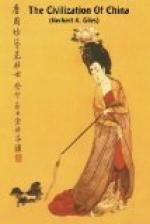The origin of the visible universe is a question on which Chinese philosophers have very naturally been led to speculate. Legend provides us with a weird being named P’an Ku, who came into existence, no one can quite say how, endowed with perfect knowledge, his function being to set the gradually developing universe in order. He is often represented pictorially with a huge adze in his hand, and engaged in constructing the world out of the matter which has just begun to take shape. With his death the detailed part of creation appeared. His breath became the wind; his voice, the thunder; his left eye, the sun; his right eye, the moon; his blood yielded rivers; his hair grew into trees and plants; his flesh became the soil; his sweat descended as rain; and the parasites which infested his body were the forerunners of the human race. This sort of stuff, however, could only appeal to the illiterate; for intellectual and educated persons something more was required. And so it came about that a system, based originally upon the quite incomprehensible Book of Changes, generally regarded as the oldest portion of the Confucian Canon, was gradually elaborated and brought to a finite state during the eleventh and twelfth centuries of our era. According to this system, there was a time, almost beyond the reach of expression in figures, when nothing at all existed. In the period which followed, there came into existence, spontaneously, a principle, which after another lapse of time resolved itself into two principles with entirely opposite characteristics. One of these principles represented light, heat, masculinity, and similar phenomena classed as positive; the other represented darkness, cold, femininity, and other phenomena classed as negative. The interaction of these two principles in duly adjusted proportions produced the five elements, earth, fire, water, wood, and metal; and with their assistance all Nature as we see it around us was easily and rapidly developed. Such is the Confucian theory, at any rate so called, for it cannot be shown that Confucius ever entertained these notions, and his alleged connexion with the Canon of Changes is itself of doubtful authenticity.
Chuang Tzu (Chwongdza), a philosopher of the third and fourth centuries B.C., who was not only a mystic but also a moralist and a social reformer, has something to say on the subject: “If there is existence, there must have been non-existence. And if there was a time when nothing existed, then there must have been a time before that, when even nothing did not exist. Then when nothing came into existence, could one really say whether it belonged to existence or non-existence?”




